Bachelor of IT: E-Business Technologies - Quick Loan BPEL Case Study
VerifiedAdded on 2023/06/04
|17
|4601
|74
Case Study
AI Summary
This case study analyzes the application of e-business technologies, specifically focusing on the implementation of Business Process Execution Language (BPEL) by Quick Loan Company. The document explores the evolution of e-business, the benefits of BPEL, and its integration with existing loan systems. It delves into the features of BPEL, including orchestration, interoperability, and asynchronous web services. The study examines how BPEL can be used to streamline processes, improve customer relationship management, and adapt to changing market dynamics. The case study also covers the implementation of BPEL without disrupting existing business conditions, emphasizing the importance of service-oriented architecture and web service standards. Various diagrams are provided to illustrate concepts such as Enterprise Service Bus architecture, BPEL benefits, tool interoperability, synchronous and asynchronous web services, and parallel flow activities. The conclusion summarizes the key findings and implications of applying BPEL in the context of Quick Loan Company's e-business strategy.
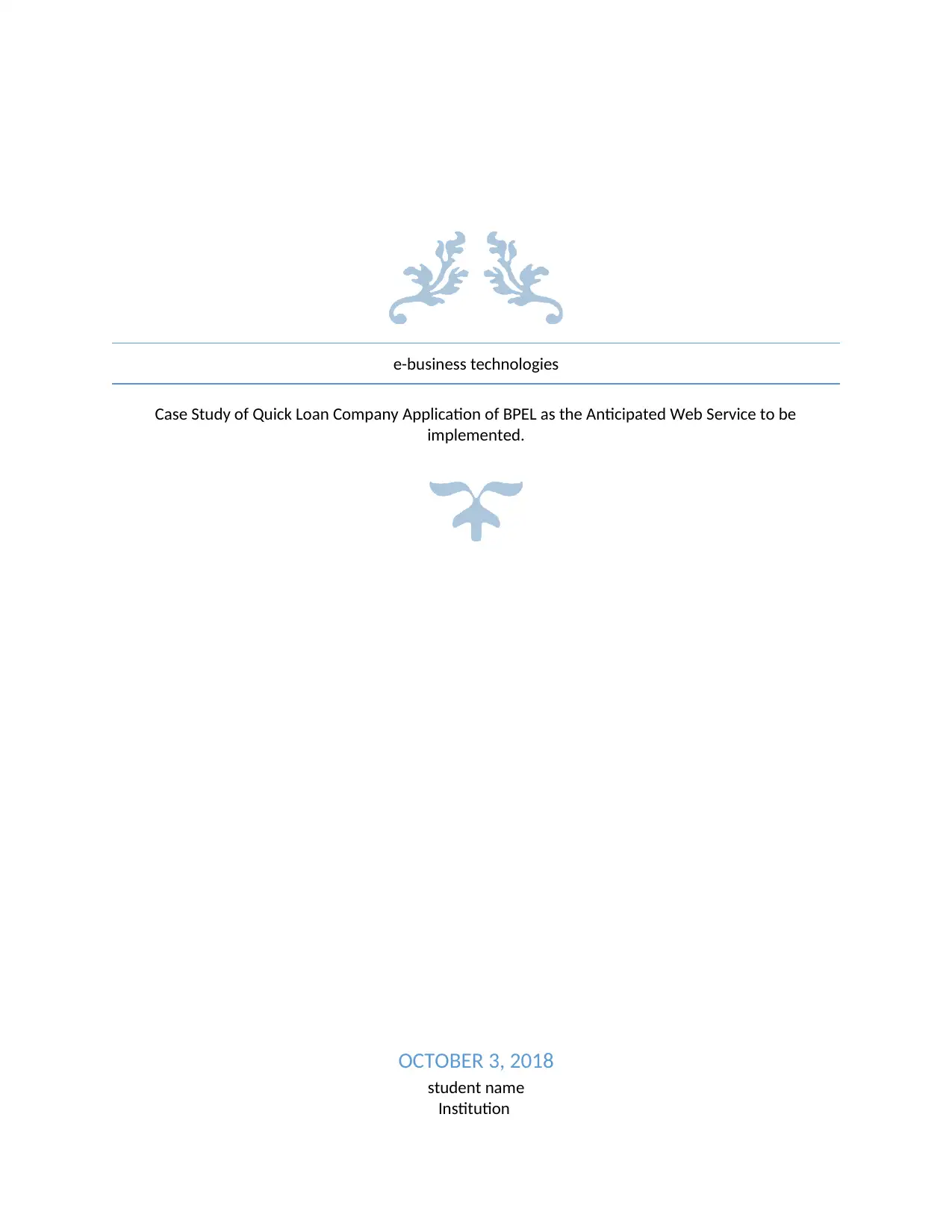
e-business technologies
Case Study of Quick Loan Company Application of BPEL as the Anticipated Web Service to be
implemented.
OCTOBER 3, 2018
student name
Institution
Case Study of Quick Loan Company Application of BPEL as the Anticipated Web Service to be
implemented.
OCTOBER 3, 2018
student name
Institution
Paraphrase This Document
Need a fresh take? Get an instant paraphrase of this document with our AI Paraphraser
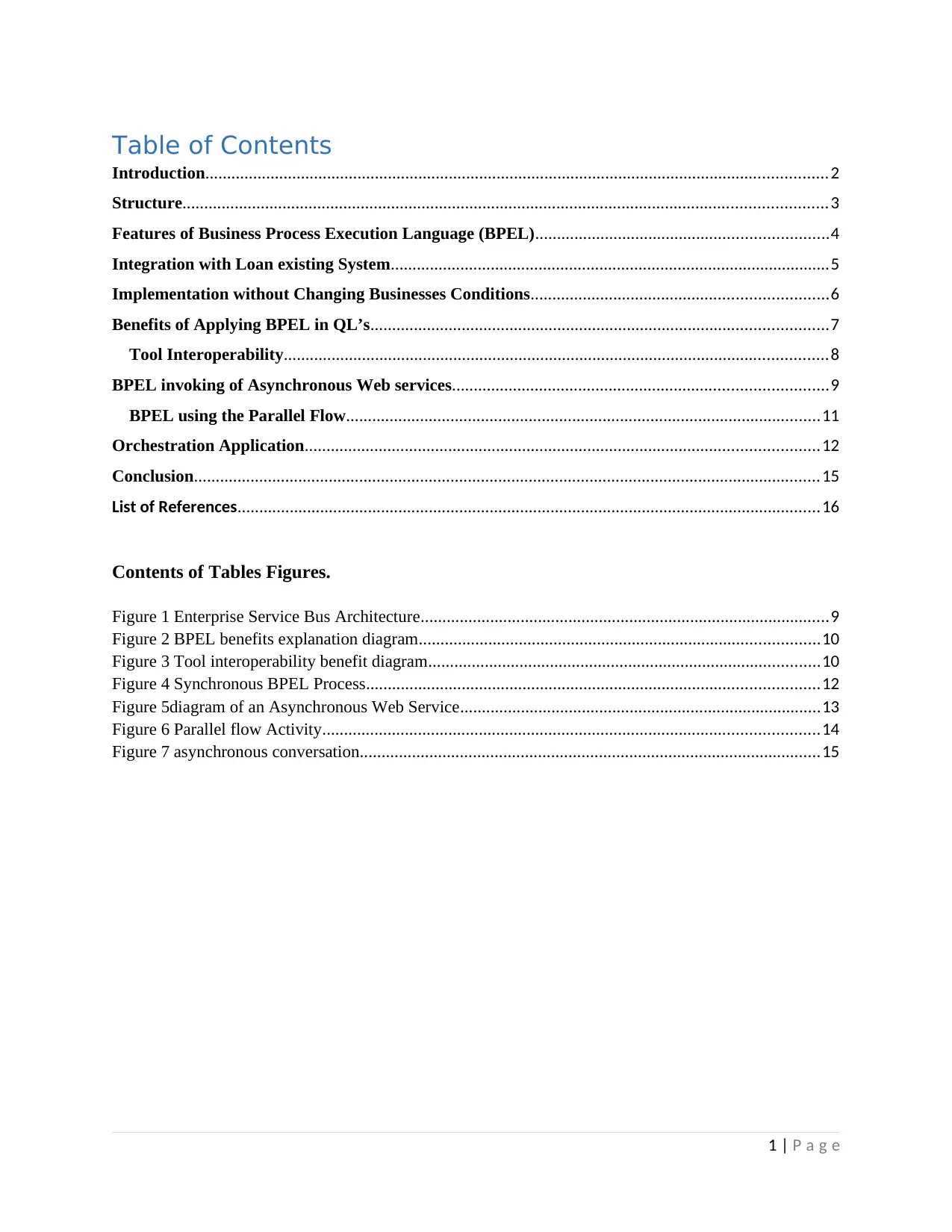
Table of Contents
Introduction...............................................................................................................................................2
Structure....................................................................................................................................................3
Features of Business Process Execution Language (BPEL)...................................................................4
Integration with Loan existing System.....................................................................................................5
Implementation without Changing Businesses Conditions....................................................................6
Benefits of Applying BPEL in QL’s.........................................................................................................7
Tool Interoperability.............................................................................................................................8
BPEL invoking of Asynchronous Web services......................................................................................9
BPEL using the Parallel Flow.............................................................................................................11
Orchestration Application......................................................................................................................12
Conclusion................................................................................................................................................15
List of References......................................................................................................................................16
Contents of Tables Figures.
Figure 1 Enterprise Service Bus Architecture..............................................................................................9
Figure 2 BPEL benefits explanation diagram............................................................................................10
Figure 3 Tool interoperability benefit diagram..........................................................................................10
Figure 4 Synchronous BPEL Process........................................................................................................12
Figure 5diagram of an Asynchronous Web Service...................................................................................13
Figure 6 Parallel flow Activity..................................................................................................................14
Figure 7 asynchronous conversation..........................................................................................................15
1 | P a g e
Introduction...............................................................................................................................................2
Structure....................................................................................................................................................3
Features of Business Process Execution Language (BPEL)...................................................................4
Integration with Loan existing System.....................................................................................................5
Implementation without Changing Businesses Conditions....................................................................6
Benefits of Applying BPEL in QL’s.........................................................................................................7
Tool Interoperability.............................................................................................................................8
BPEL invoking of Asynchronous Web services......................................................................................9
BPEL using the Parallel Flow.............................................................................................................11
Orchestration Application......................................................................................................................12
Conclusion................................................................................................................................................15
List of References......................................................................................................................................16
Contents of Tables Figures.
Figure 1 Enterprise Service Bus Architecture..............................................................................................9
Figure 2 BPEL benefits explanation diagram............................................................................................10
Figure 3 Tool interoperability benefit diagram..........................................................................................10
Figure 4 Synchronous BPEL Process........................................................................................................12
Figure 5diagram of an Asynchronous Web Service...................................................................................13
Figure 6 Parallel flow Activity..................................................................................................................14
Figure 7 asynchronous conversation..........................................................................................................15
1 | P a g e
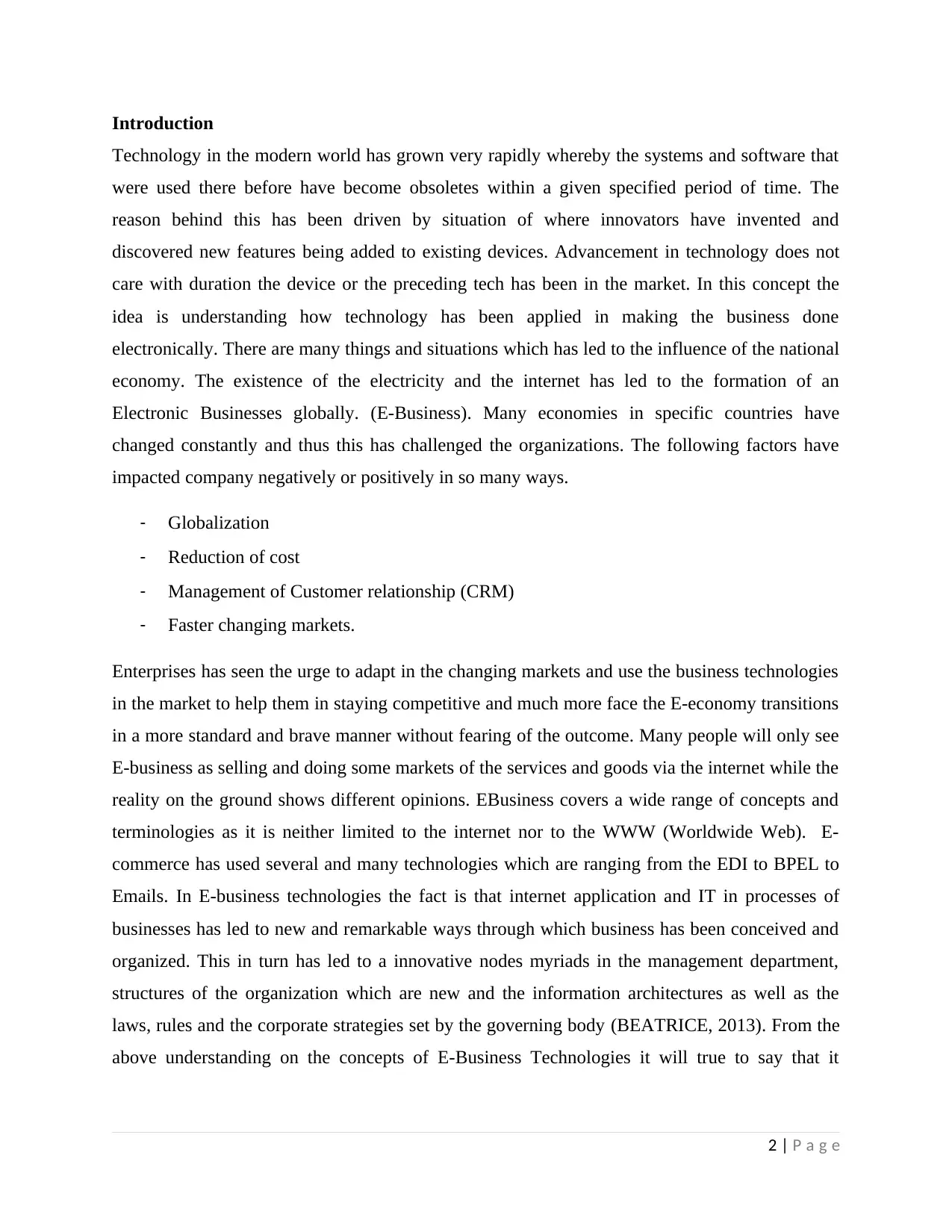
Introduction
Technology in the modern world has grown very rapidly whereby the systems and software that
were used there before have become obsoletes within a given specified period of time. The
reason behind this has been driven by situation of where innovators have invented and
discovered new features being added to existing devices. Advancement in technology does not
care with duration the device or the preceding tech has been in the market. In this concept the
idea is understanding how technology has been applied in making the business done
electronically. There are many things and situations which has led to the influence of the national
economy. The existence of the electricity and the internet has led to the formation of an
Electronic Businesses globally. (E-Business). Many economies in specific countries have
changed constantly and thus this has challenged the organizations. The following factors have
impacted company negatively or positively in so many ways.
- Globalization
- Reduction of cost
- Management of Customer relationship (CRM)
- Faster changing markets.
Enterprises has seen the urge to adapt in the changing markets and use the business technologies
in the market to help them in staying competitive and much more face the E-economy transitions
in a more standard and brave manner without fearing of the outcome. Many people will only see
E-business as selling and doing some markets of the services and goods via the internet while the
reality on the ground shows different opinions. EBusiness covers a wide range of concepts and
terminologies as it is neither limited to the internet nor to the WWW (Worldwide Web). E-
commerce has used several and many technologies which are ranging from the EDI to BPEL to
Emails. In E-business technologies the fact is that internet application and IT in processes of
businesses has led to new and remarkable ways through which business has been conceived and
organized. This in turn has led to a innovative nodes myriads in the management department,
structures of the organization which are new and the information architectures as well as the
laws, rules and the corporate strategies set by the governing body (BEATRICE, 2013). From the
above understanding on the concepts of E-Business Technologies it will true to say that it
2 | P a g e
Technology in the modern world has grown very rapidly whereby the systems and software that
were used there before have become obsoletes within a given specified period of time. The
reason behind this has been driven by situation of where innovators have invented and
discovered new features being added to existing devices. Advancement in technology does not
care with duration the device or the preceding tech has been in the market. In this concept the
idea is understanding how technology has been applied in making the business done
electronically. There are many things and situations which has led to the influence of the national
economy. The existence of the electricity and the internet has led to the formation of an
Electronic Businesses globally. (E-Business). Many economies in specific countries have
changed constantly and thus this has challenged the organizations. The following factors have
impacted company negatively or positively in so many ways.
- Globalization
- Reduction of cost
- Management of Customer relationship (CRM)
- Faster changing markets.
Enterprises has seen the urge to adapt in the changing markets and use the business technologies
in the market to help them in staying competitive and much more face the E-economy transitions
in a more standard and brave manner without fearing of the outcome. Many people will only see
E-business as selling and doing some markets of the services and goods via the internet while the
reality on the ground shows different opinions. EBusiness covers a wide range of concepts and
terminologies as it is neither limited to the internet nor to the WWW (Worldwide Web). E-
commerce has used several and many technologies which are ranging from the EDI to BPEL to
Emails. In E-business technologies the fact is that internet application and IT in processes of
businesses has led to new and remarkable ways through which business has been conceived and
organized. This in turn has led to a innovative nodes myriads in the management department,
structures of the organization which are new and the information architectures as well as the
laws, rules and the corporate strategies set by the governing body (BEATRICE, 2013). From the
above understanding on the concepts of E-Business Technologies it will true to say that it
2 | P a g e
⊘ This is a preview!⊘
Do you want full access?
Subscribe today to unlock all pages.

Trusted by 1+ million students worldwide
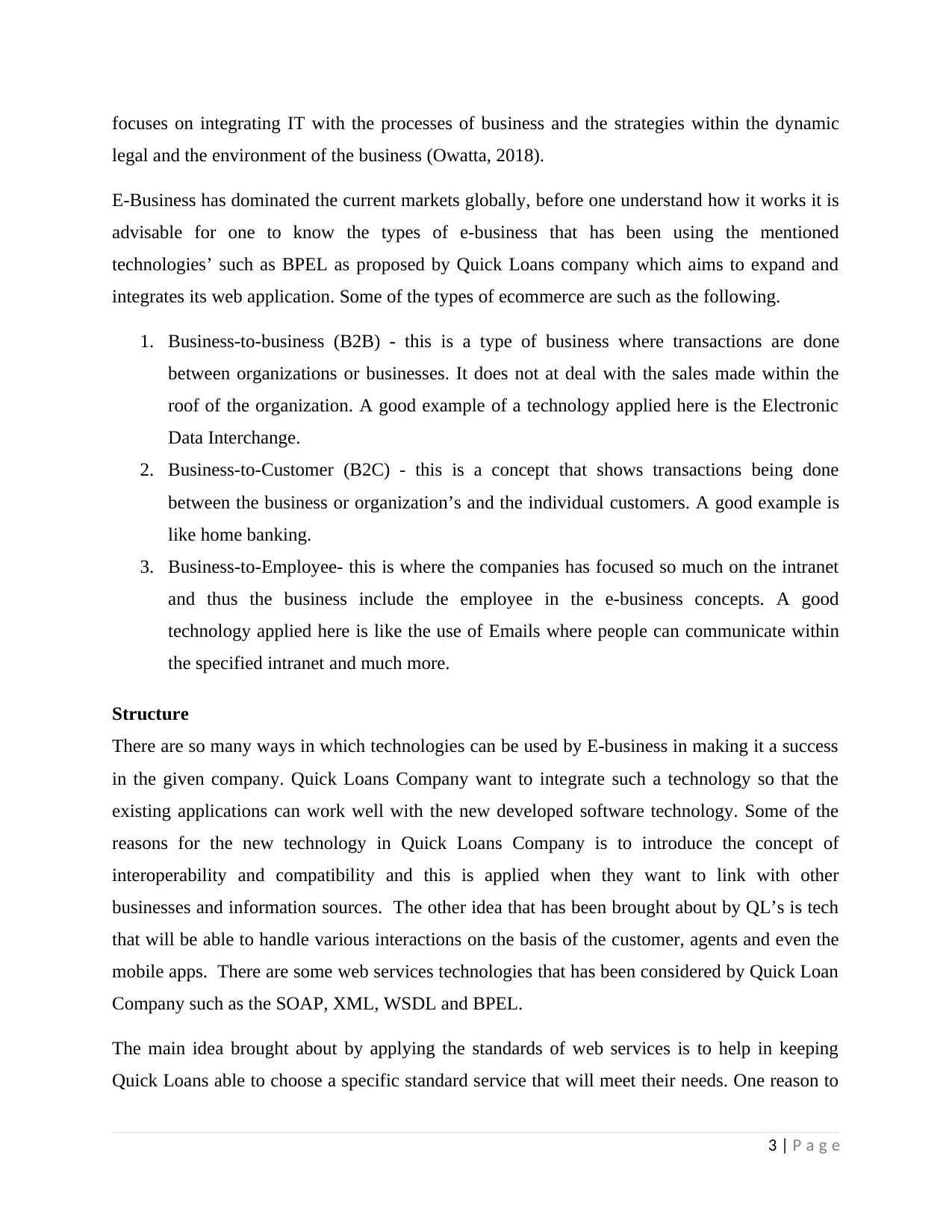
focuses on integrating IT with the processes of business and the strategies within the dynamic
legal and the environment of the business (Owatta, 2018).
E-Business has dominated the current markets globally, before one understand how it works it is
advisable for one to know the types of e-business that has been using the mentioned
technologies’ such as BPEL as proposed by Quick Loans company which aims to expand and
integrates its web application. Some of the types of ecommerce are such as the following.
1. Business-to-business (B2B) - this is a type of business where transactions are done
between organizations or businesses. It does not at deal with the sales made within the
roof of the organization. A good example of a technology applied here is the Electronic
Data Interchange.
2. Business-to-Customer (B2C) - this is a concept that shows transactions being done
between the business or organization’s and the individual customers. A good example is
like home banking.
3. Business-to-Employee- this is where the companies has focused so much on the intranet
and thus the business include the employee in the e-business concepts. A good
technology applied here is like the use of Emails where people can communicate within
the specified intranet and much more.
Structure
There are so many ways in which technologies can be used by E-business in making it a success
in the given company. Quick Loans Company want to integrate such a technology so that the
existing applications can work well with the new developed software technology. Some of the
reasons for the new technology in Quick Loans Company is to introduce the concept of
interoperability and compatibility and this is applied when they want to link with other
businesses and information sources. The other idea that has been brought about by QL’s is tech
that will be able to handle various interactions on the basis of the customer, agents and even the
mobile apps. There are some web services technologies that has been considered by Quick Loan
Company such as the SOAP, XML, WSDL and BPEL.
The main idea brought about by applying the standards of web services is to help in keeping
Quick Loans able to choose a specific standard service that will meet their needs. One reason to
3 | P a g e
legal and the environment of the business (Owatta, 2018).
E-Business has dominated the current markets globally, before one understand how it works it is
advisable for one to know the types of e-business that has been using the mentioned
technologies’ such as BPEL as proposed by Quick Loans company which aims to expand and
integrates its web application. Some of the types of ecommerce are such as the following.
1. Business-to-business (B2B) - this is a type of business where transactions are done
between organizations or businesses. It does not at deal with the sales made within the
roof of the organization. A good example of a technology applied here is the Electronic
Data Interchange.
2. Business-to-Customer (B2C) - this is a concept that shows transactions being done
between the business or organization’s and the individual customers. A good example is
like home banking.
3. Business-to-Employee- this is where the companies has focused so much on the intranet
and thus the business include the employee in the e-business concepts. A good
technology applied here is like the use of Emails where people can communicate within
the specified intranet and much more.
Structure
There are so many ways in which technologies can be used by E-business in making it a success
in the given company. Quick Loans Company want to integrate such a technology so that the
existing applications can work well with the new developed software technology. Some of the
reasons for the new technology in Quick Loans Company is to introduce the concept of
interoperability and compatibility and this is applied when they want to link with other
businesses and information sources. The other idea that has been brought about by QL’s is tech
that will be able to handle various interactions on the basis of the customer, agents and even the
mobile apps. There are some web services technologies that has been considered by Quick Loan
Company such as the SOAP, XML, WSDL and BPEL.
The main idea brought about by applying the standards of web services is to help in keeping
Quick Loans able to choose a specific standard service that will meet their needs. One reason to
3 | P a g e
Paraphrase This Document
Need a fresh take? Get an instant paraphrase of this document with our AI Paraphraser
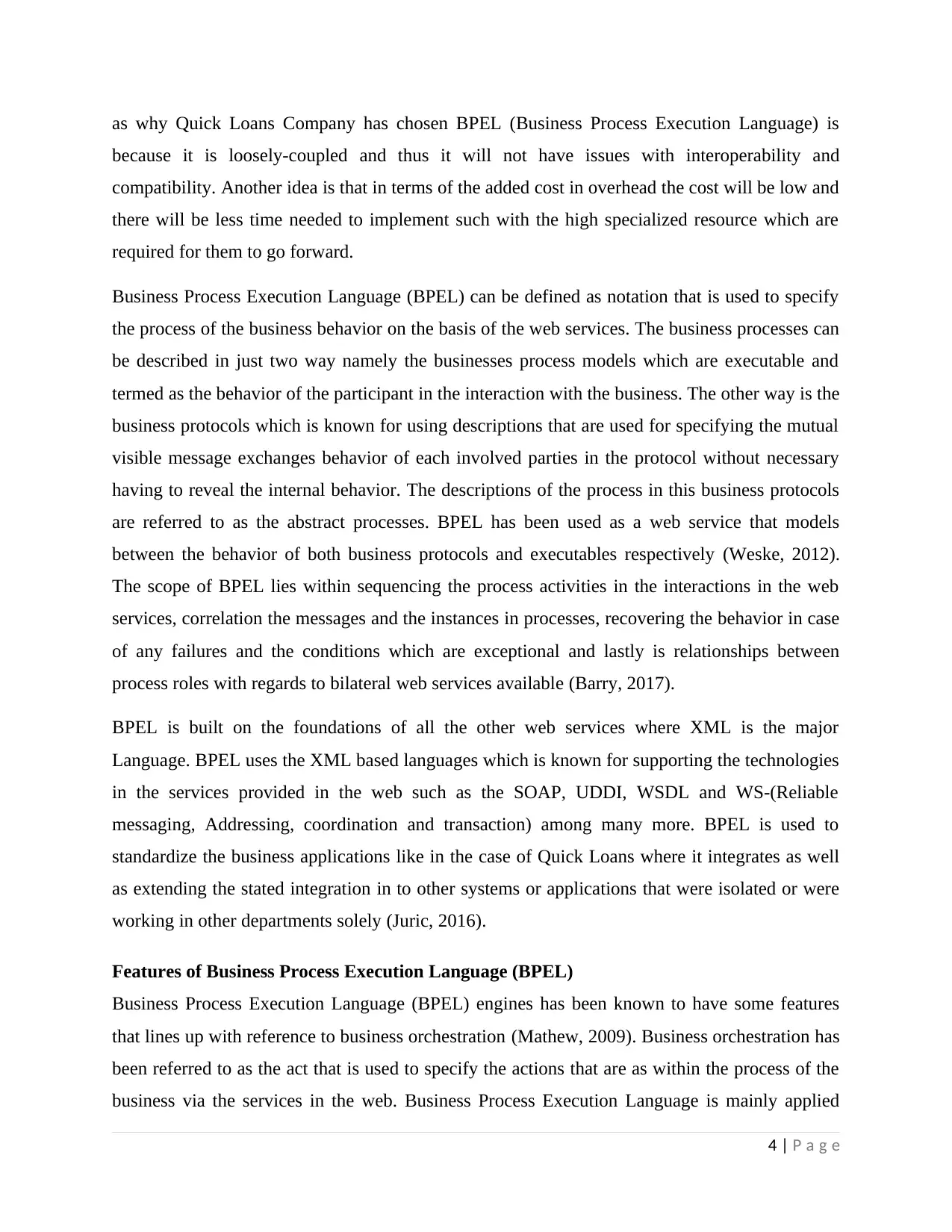
as why Quick Loans Company has chosen BPEL (Business Process Execution Language) is
because it is loosely-coupled and thus it will not have issues with interoperability and
compatibility. Another idea is that in terms of the added cost in overhead the cost will be low and
there will be less time needed to implement such with the high specialized resource which are
required for them to go forward.
Business Process Execution Language (BPEL) can be defined as notation that is used to specify
the process of the business behavior on the basis of the web services. The business processes can
be described in just two way namely the businesses process models which are executable and
termed as the behavior of the participant in the interaction with the business. The other way is the
business protocols which is known for using descriptions that are used for specifying the mutual
visible message exchanges behavior of each involved parties in the protocol without necessary
having to reveal the internal behavior. The descriptions of the process in this business protocols
are referred to as the abstract processes. BPEL has been used as a web service that models
between the behavior of both business protocols and executables respectively (Weske, 2012).
The scope of BPEL lies within sequencing the process activities in the interactions in the web
services, correlation the messages and the instances in processes, recovering the behavior in case
of any failures and the conditions which are exceptional and lastly is relationships between
process roles with regards to bilateral web services available (Barry, 2017).
BPEL is built on the foundations of all the other web services where XML is the major
Language. BPEL uses the XML based languages which is known for supporting the technologies
in the services provided in the web such as the SOAP, UDDI, WSDL and WS-(Reliable
messaging, Addressing, coordination and transaction) among many more. BPEL is used to
standardize the business applications like in the case of Quick Loans where it integrates as well
as extending the stated integration in to other systems or applications that were isolated or were
working in other departments solely (Juric, 2016).
Features of Business Process Execution Language (BPEL)
Business Process Execution Language (BPEL) engines has been known to have some features
that lines up with reference to business orchestration (Mathew, 2009). Business orchestration has
been referred to as the act that is used to specify the actions that are as within the process of the
business via the services in the web. Business Process Execution Language is mainly applied
4 | P a g e
because it is loosely-coupled and thus it will not have issues with interoperability and
compatibility. Another idea is that in terms of the added cost in overhead the cost will be low and
there will be less time needed to implement such with the high specialized resource which are
required for them to go forward.
Business Process Execution Language (BPEL) can be defined as notation that is used to specify
the process of the business behavior on the basis of the web services. The business processes can
be described in just two way namely the businesses process models which are executable and
termed as the behavior of the participant in the interaction with the business. The other way is the
business protocols which is known for using descriptions that are used for specifying the mutual
visible message exchanges behavior of each involved parties in the protocol without necessary
having to reveal the internal behavior. The descriptions of the process in this business protocols
are referred to as the abstract processes. BPEL has been used as a web service that models
between the behavior of both business protocols and executables respectively (Weske, 2012).
The scope of BPEL lies within sequencing the process activities in the interactions in the web
services, correlation the messages and the instances in processes, recovering the behavior in case
of any failures and the conditions which are exceptional and lastly is relationships between
process roles with regards to bilateral web services available (Barry, 2017).
BPEL is built on the foundations of all the other web services where XML is the major
Language. BPEL uses the XML based languages which is known for supporting the technologies
in the services provided in the web such as the SOAP, UDDI, WSDL and WS-(Reliable
messaging, Addressing, coordination and transaction) among many more. BPEL is used to
standardize the business applications like in the case of Quick Loans where it integrates as well
as extending the stated integration in to other systems or applications that were isolated or were
working in other departments solely (Juric, 2016).
Features of Business Process Execution Language (BPEL)
Business Process Execution Language (BPEL) engines has been known to have some features
that lines up with reference to business orchestration (Mathew, 2009). Business orchestration has
been referred to as the act that is used to specify the actions that are as within the process of the
business via the services in the web. Business Process Execution Language is mainly applied
4 | P a g e
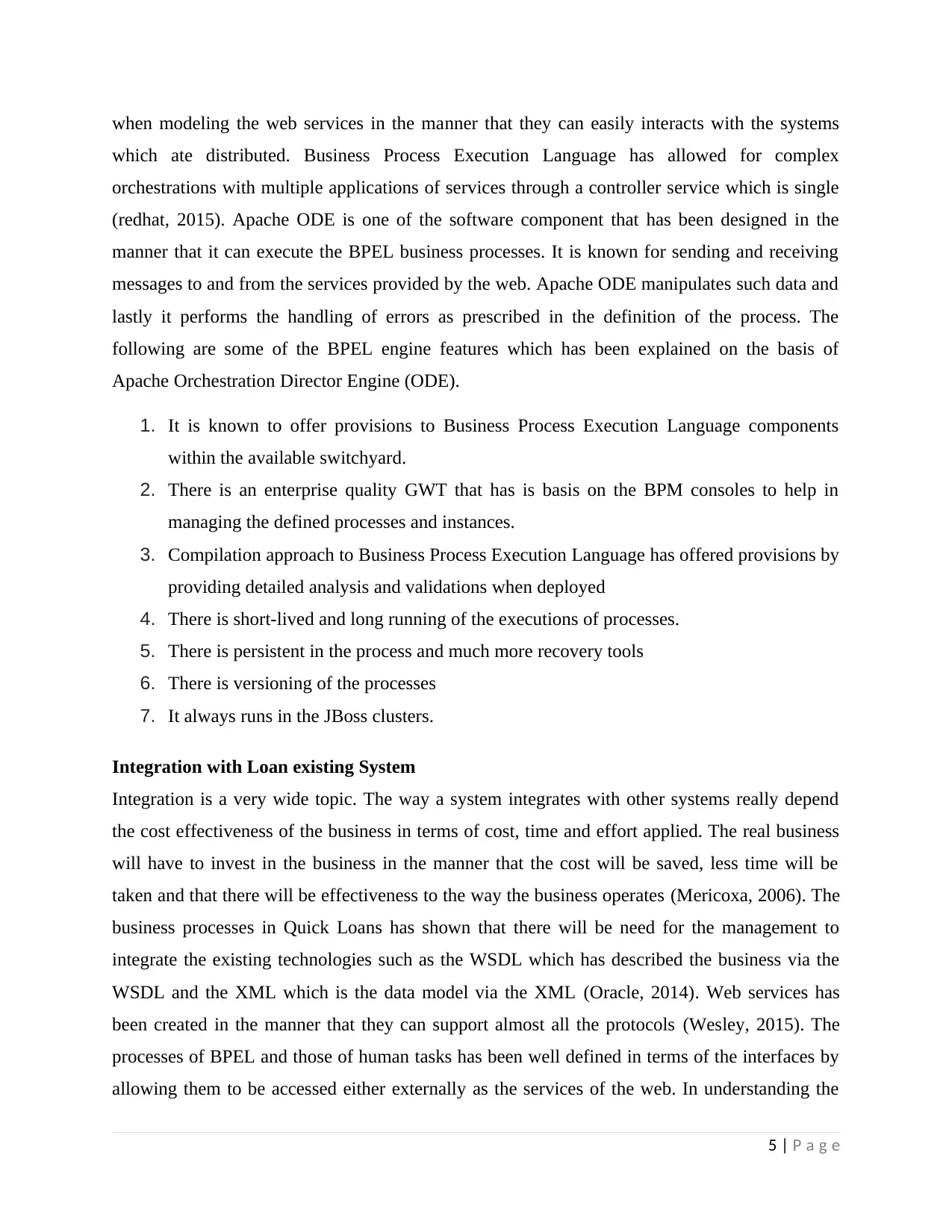
when modeling the web services in the manner that they can easily interacts with the systems
which ate distributed. Business Process Execution Language has allowed for complex
orchestrations with multiple applications of services through a controller service which is single
(redhat, 2015). Apache ODE is one of the software component that has been designed in the
manner that it can execute the BPEL business processes. It is known for sending and receiving
messages to and from the services provided by the web. Apache ODE manipulates such data and
lastly it performs the handling of errors as prescribed in the definition of the process. The
following are some of the BPEL engine features which has been explained on the basis of
Apache Orchestration Director Engine (ODE).
1. It is known to offer provisions to Business Process Execution Language components
within the available switchyard.
2. There is an enterprise quality GWT that has is basis on the BPM consoles to help in
managing the defined processes and instances.
3. Compilation approach to Business Process Execution Language has offered provisions by
providing detailed analysis and validations when deployed
4. There is short-lived and long running of the executions of processes.
5. There is persistent in the process and much more recovery tools
6. There is versioning of the processes
7. It always runs in the JBoss clusters.
Integration with Loan existing System
Integration is a very wide topic. The way a system integrates with other systems really depend
the cost effectiveness of the business in terms of cost, time and effort applied. The real business
will have to invest in the business in the manner that the cost will be saved, less time will be
taken and that there will be effectiveness to the way the business operates (Mericoxa, 2006). The
business processes in Quick Loans has shown that there will be need for the management to
integrate the existing technologies such as the WSDL which has described the business via the
WSDL and the XML which is the data model via the XML (Oracle, 2014). Web services has
been created in the manner that they can support almost all the protocols (Wesley, 2015). The
processes of BPEL and those of human tasks has been well defined in terms of the interfaces by
allowing them to be accessed either externally as the services of the web. In understanding the
5 | P a g e
which ate distributed. Business Process Execution Language has allowed for complex
orchestrations with multiple applications of services through a controller service which is single
(redhat, 2015). Apache ODE is one of the software component that has been designed in the
manner that it can execute the BPEL business processes. It is known for sending and receiving
messages to and from the services provided by the web. Apache ODE manipulates such data and
lastly it performs the handling of errors as prescribed in the definition of the process. The
following are some of the BPEL engine features which has been explained on the basis of
Apache Orchestration Director Engine (ODE).
1. It is known to offer provisions to Business Process Execution Language components
within the available switchyard.
2. There is an enterprise quality GWT that has is basis on the BPM consoles to help in
managing the defined processes and instances.
3. Compilation approach to Business Process Execution Language has offered provisions by
providing detailed analysis and validations when deployed
4. There is short-lived and long running of the executions of processes.
5. There is persistent in the process and much more recovery tools
6. There is versioning of the processes
7. It always runs in the JBoss clusters.
Integration with Loan existing System
Integration is a very wide topic. The way a system integrates with other systems really depend
the cost effectiveness of the business in terms of cost, time and effort applied. The real business
will have to invest in the business in the manner that the cost will be saved, less time will be
taken and that there will be effectiveness to the way the business operates (Mericoxa, 2006). The
business processes in Quick Loans has shown that there will be need for the management to
integrate the existing technologies such as the WSDL which has described the business via the
WSDL and the XML which is the data model via the XML (Oracle, 2014). Web services has
been created in the manner that they can support almost all the protocols (Wesley, 2015). The
processes of BPEL and those of human tasks has been well defined in terms of the interfaces by
allowing them to be accessed either externally as the services of the web. In understanding the
5 | P a g e
⊘ This is a preview!⊘
Do you want full access?
Subscribe today to unlock all pages.

Trusted by 1+ million students worldwide
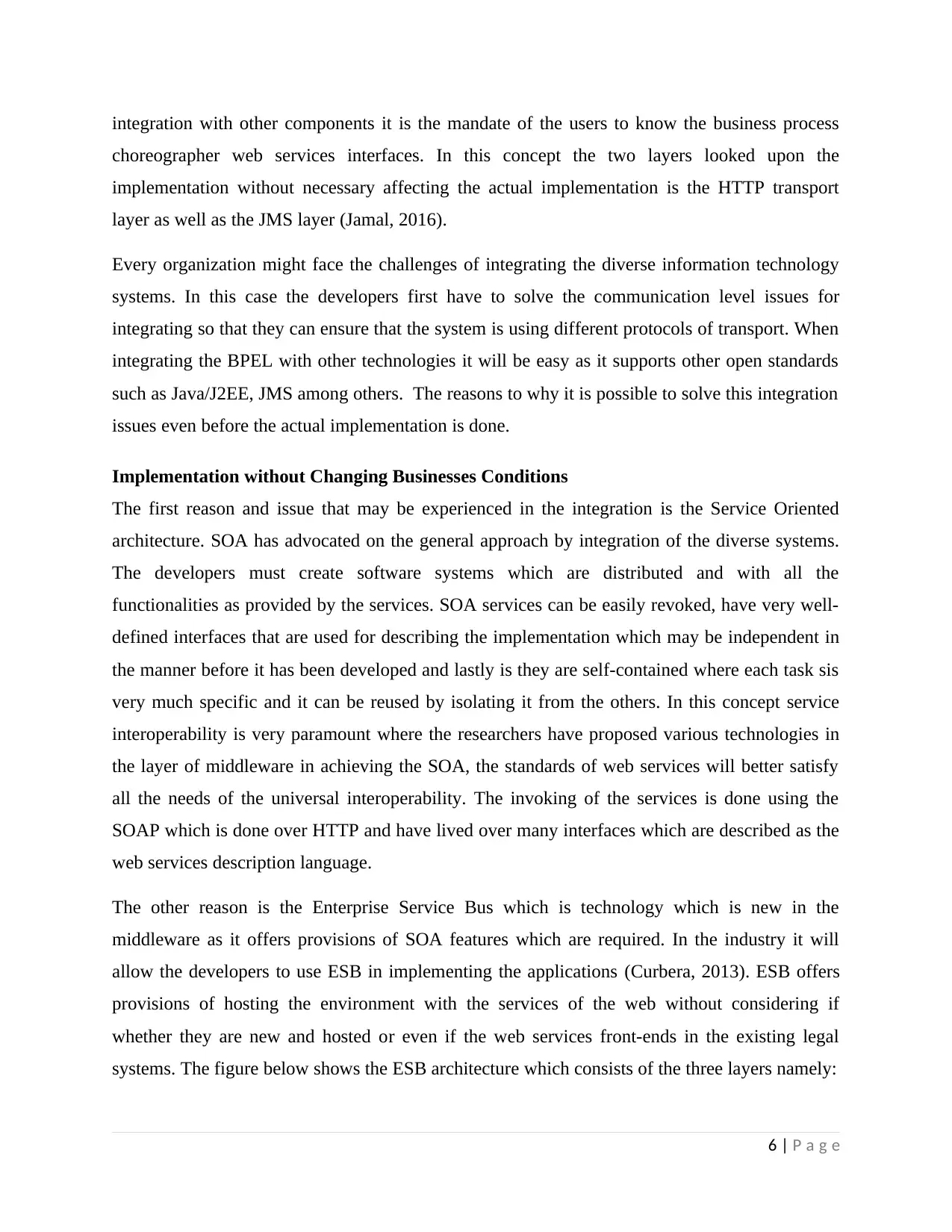
integration with other components it is the mandate of the users to know the business process
choreographer web services interfaces. In this concept the two layers looked upon the
implementation without necessary affecting the actual implementation is the HTTP transport
layer as well as the JMS layer (Jamal, 2016).
Every organization might face the challenges of integrating the diverse information technology
systems. In this case the developers first have to solve the communication level issues for
integrating so that they can ensure that the system is using different protocols of transport. When
integrating the BPEL with other technologies it will be easy as it supports other open standards
such as Java/J2EE, JMS among others. The reasons to why it is possible to solve this integration
issues even before the actual implementation is done.
Implementation without Changing Businesses Conditions
The first reason and issue that may be experienced in the integration is the Service Oriented
architecture. SOA has advocated on the general approach by integration of the diverse systems.
The developers must create software systems which are distributed and with all the
functionalities as provided by the services. SOA services can be easily revoked, have very well-
defined interfaces that are used for describing the implementation which may be independent in
the manner before it has been developed and lastly is they are self-contained where each task sis
very much specific and it can be reused by isolating it from the others. In this concept service
interoperability is very paramount where the researchers have proposed various technologies in
the layer of middleware in achieving the SOA, the standards of web services will better satisfy
all the needs of the universal interoperability. The invoking of the services is done using the
SOAP which is done over HTTP and have lived over many interfaces which are described as the
web services description language.
The other reason is the Enterprise Service Bus which is technology which is new in the
middleware as it offers provisions of SOA features which are required. In the industry it will
allow the developers to use ESB in implementing the applications (Curbera, 2013). ESB offers
provisions of hosting the environment with the services of the web without considering if
whether they are new and hosted or even if the web services front-ends in the existing legal
systems. The figure below shows the ESB architecture which consists of the three layers namely:
6 | P a g e
choreographer web services interfaces. In this concept the two layers looked upon the
implementation without necessary affecting the actual implementation is the HTTP transport
layer as well as the JMS layer (Jamal, 2016).
Every organization might face the challenges of integrating the diverse information technology
systems. In this case the developers first have to solve the communication level issues for
integrating so that they can ensure that the system is using different protocols of transport. When
integrating the BPEL with other technologies it will be easy as it supports other open standards
such as Java/J2EE, JMS among others. The reasons to why it is possible to solve this integration
issues even before the actual implementation is done.
Implementation without Changing Businesses Conditions
The first reason and issue that may be experienced in the integration is the Service Oriented
architecture. SOA has advocated on the general approach by integration of the diverse systems.
The developers must create software systems which are distributed and with all the
functionalities as provided by the services. SOA services can be easily revoked, have very well-
defined interfaces that are used for describing the implementation which may be independent in
the manner before it has been developed and lastly is they are self-contained where each task sis
very much specific and it can be reused by isolating it from the others. In this concept service
interoperability is very paramount where the researchers have proposed various technologies in
the layer of middleware in achieving the SOA, the standards of web services will better satisfy
all the needs of the universal interoperability. The invoking of the services is done using the
SOAP which is done over HTTP and have lived over many interfaces which are described as the
web services description language.
The other reason is the Enterprise Service Bus which is technology which is new in the
middleware as it offers provisions of SOA features which are required. In the industry it will
allow the developers to use ESB in implementing the applications (Curbera, 2013). ESB offers
provisions of hosting the environment with the services of the web without considering if
whether they are new and hosted or even if the web services front-ends in the existing legal
systems. The figure below shows the ESB architecture which consists of the three layers namely:
6 | P a g e
Paraphrase This Document
Need a fresh take? Get an instant paraphrase of this document with our AI Paraphraser
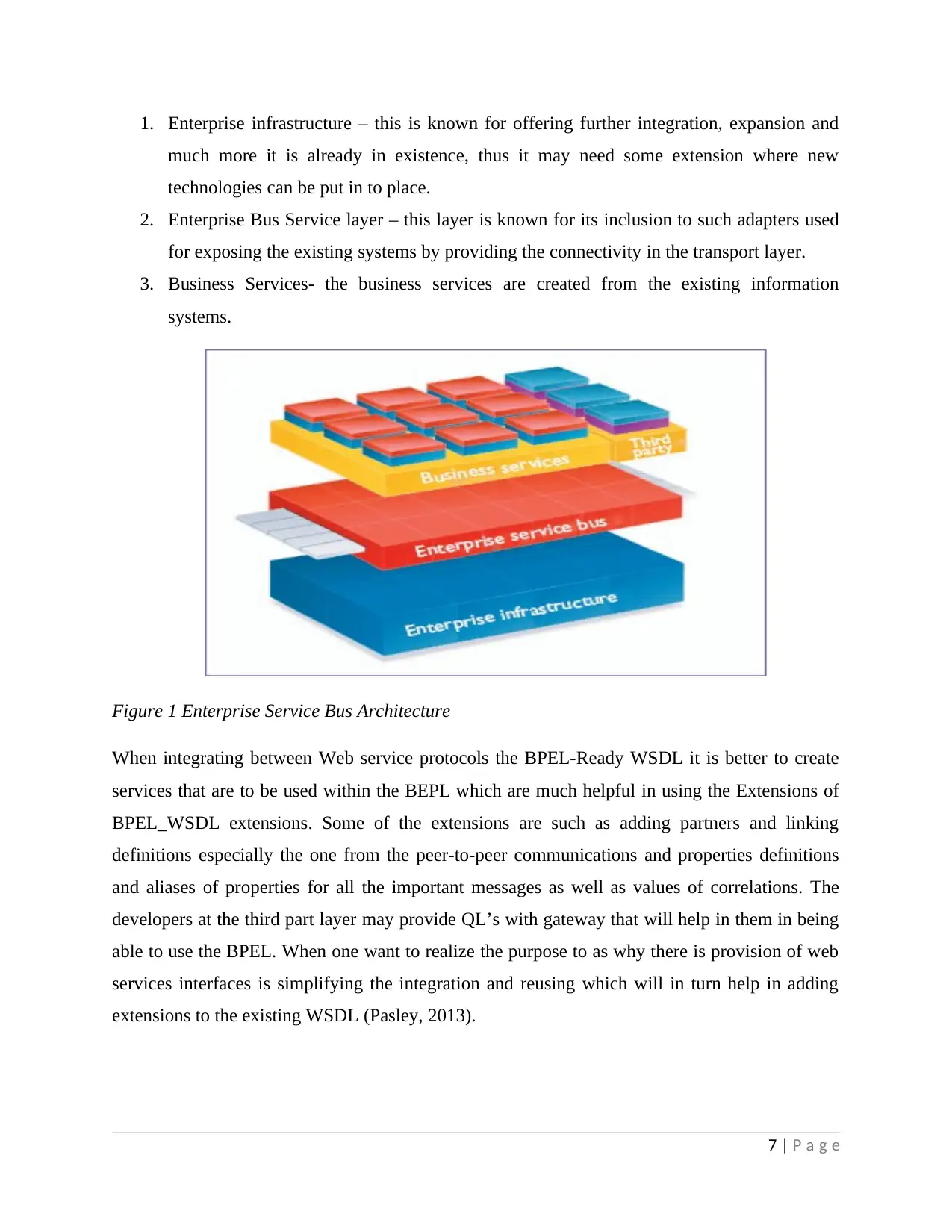
1. Enterprise infrastructure – this is known for offering further integration, expansion and
much more it is already in existence, thus it may need some extension where new
technologies can be put in to place.
2. Enterprise Bus Service layer – this layer is known for its inclusion to such adapters used
for exposing the existing systems by providing the connectivity in the transport layer.
3. Business Services- the business services are created from the existing information
systems.
Figure 1 Enterprise Service Bus Architecture
When integrating between Web service protocols the BPEL-Ready WSDL it is better to create
services that are to be used within the BEPL which are much helpful in using the Extensions of
BPEL_WSDL extensions. Some of the extensions are such as adding partners and linking
definitions especially the one from the peer-to-peer communications and properties definitions
and aliases of properties for all the important messages as well as values of correlations. The
developers at the third part layer may provide QL’s with gateway that will help in them in being
able to use the BPEL. When one want to realize the purpose to as why there is provision of web
services interfaces is simplifying the integration and reusing which will in turn help in adding
extensions to the existing WSDL (Pasley, 2013).
7 | P a g e
much more it is already in existence, thus it may need some extension where new
technologies can be put in to place.
2. Enterprise Bus Service layer – this layer is known for its inclusion to such adapters used
for exposing the existing systems by providing the connectivity in the transport layer.
3. Business Services- the business services are created from the existing information
systems.
Figure 1 Enterprise Service Bus Architecture
When integrating between Web service protocols the BPEL-Ready WSDL it is better to create
services that are to be used within the BEPL which are much helpful in using the Extensions of
BPEL_WSDL extensions. Some of the extensions are such as adding partners and linking
definitions especially the one from the peer-to-peer communications and properties definitions
and aliases of properties for all the important messages as well as values of correlations. The
developers at the third part layer may provide QL’s with gateway that will help in them in being
able to use the BPEL. When one want to realize the purpose to as why there is provision of web
services interfaces is simplifying the integration and reusing which will in turn help in adding
extensions to the existing WSDL (Pasley, 2013).
7 | P a g e
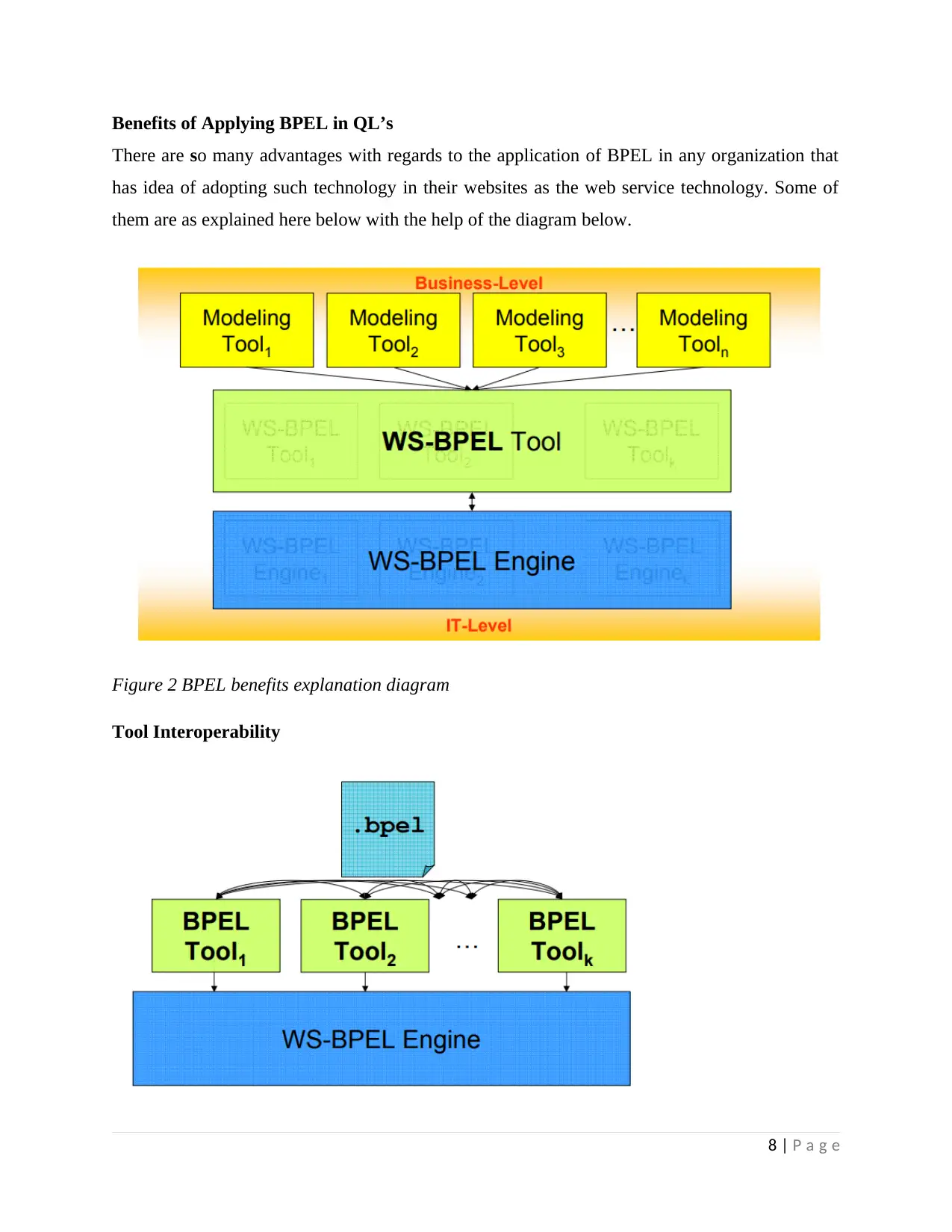
Benefits of Applying BPEL in QL’s
There are so many advantages with regards to the application of BPEL in any organization that
has idea of adopting such technology in their websites as the web service technology. Some of
them are as explained here below with the help of the diagram below.
Figure 2 BPEL benefits explanation diagram
Tool Interoperability
8 | P a g e
There are so many advantages with regards to the application of BPEL in any organization that
has idea of adopting such technology in their websites as the web service technology. Some of
them are as explained here below with the help of the diagram below.
Figure 2 BPEL benefits explanation diagram
Tool Interoperability
8 | P a g e
⊘ This is a preview!⊘
Do you want full access?
Subscribe today to unlock all pages.

Trusted by 1+ million students worldwide
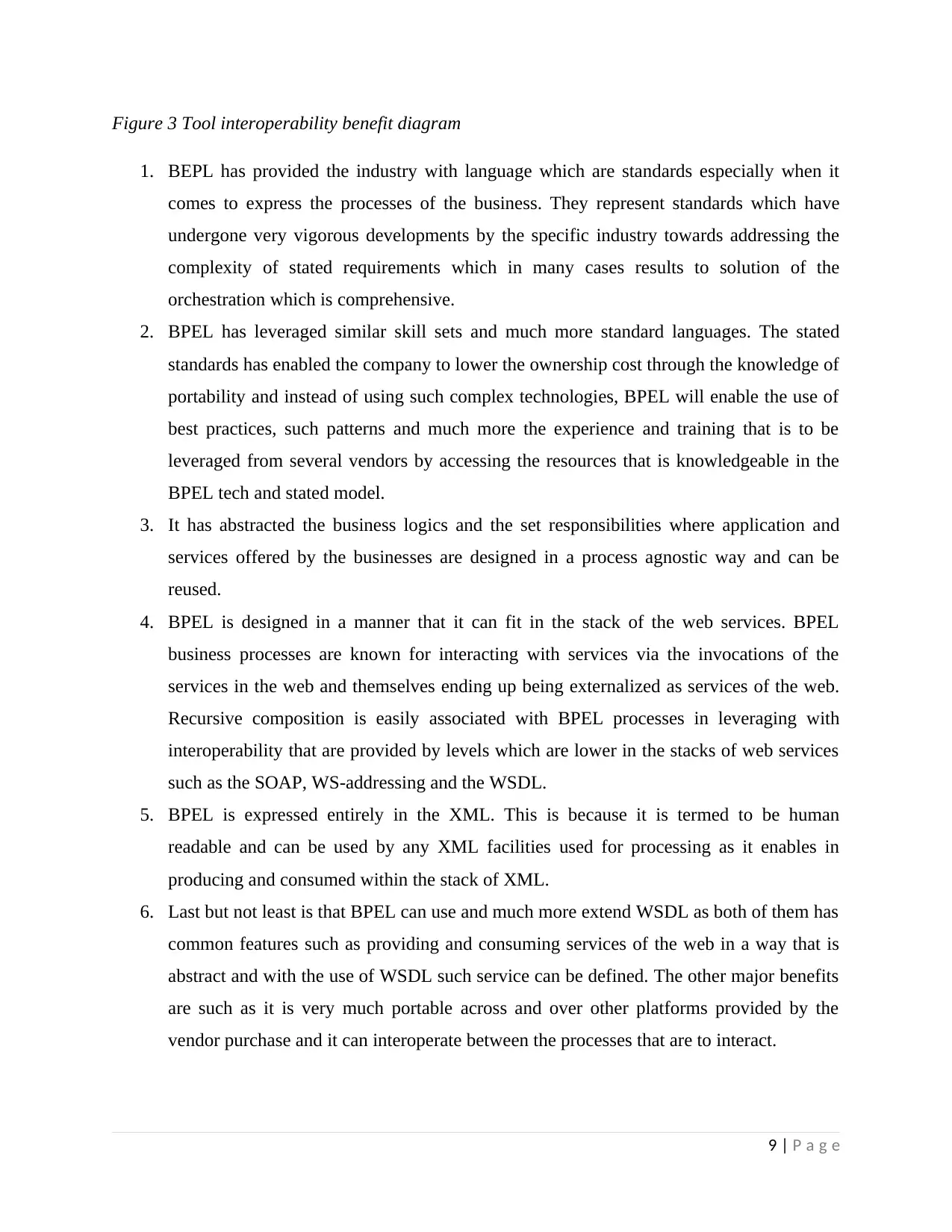
Figure 3 Tool interoperability benefit diagram
1. BEPL has provided the industry with language which are standards especially when it
comes to express the processes of the business. They represent standards which have
undergone very vigorous developments by the specific industry towards addressing the
complexity of stated requirements which in many cases results to solution of the
orchestration which is comprehensive.
2. BPEL has leveraged similar skill sets and much more standard languages. The stated
standards has enabled the company to lower the ownership cost through the knowledge of
portability and instead of using such complex technologies, BPEL will enable the use of
best practices, such patterns and much more the experience and training that is to be
leveraged from several vendors by accessing the resources that is knowledgeable in the
BPEL tech and stated model.
3. It has abstracted the business logics and the set responsibilities where application and
services offered by the businesses are designed in a process agnostic way and can be
reused.
4. BPEL is designed in a manner that it can fit in the stack of the web services. BPEL
business processes are known for interacting with services via the invocations of the
services in the web and themselves ending up being externalized as services of the web.
Recursive composition is easily associated with BPEL processes in leveraging with
interoperability that are provided by levels which are lower in the stacks of web services
such as the SOAP, WS-addressing and the WSDL.
5. BPEL is expressed entirely in the XML. This is because it is termed to be human
readable and can be used by any XML facilities used for processing as it enables in
producing and consumed within the stack of XML.
6. Last but not least is that BPEL can use and much more extend WSDL as both of them has
common features such as providing and consuming services of the web in a way that is
abstract and with the use of WSDL such service can be defined. The other major benefits
are such as it is very much portable across and over other platforms provided by the
vendor purchase and it can interoperate between the processes that are to interact.
9 | P a g e
1. BEPL has provided the industry with language which are standards especially when it
comes to express the processes of the business. They represent standards which have
undergone very vigorous developments by the specific industry towards addressing the
complexity of stated requirements which in many cases results to solution of the
orchestration which is comprehensive.
2. BPEL has leveraged similar skill sets and much more standard languages. The stated
standards has enabled the company to lower the ownership cost through the knowledge of
portability and instead of using such complex technologies, BPEL will enable the use of
best practices, such patterns and much more the experience and training that is to be
leveraged from several vendors by accessing the resources that is knowledgeable in the
BPEL tech and stated model.
3. It has abstracted the business logics and the set responsibilities where application and
services offered by the businesses are designed in a process agnostic way and can be
reused.
4. BPEL is designed in a manner that it can fit in the stack of the web services. BPEL
business processes are known for interacting with services via the invocations of the
services in the web and themselves ending up being externalized as services of the web.
Recursive composition is easily associated with BPEL processes in leveraging with
interoperability that are provided by levels which are lower in the stacks of web services
such as the SOAP, WS-addressing and the WSDL.
5. BPEL is expressed entirely in the XML. This is because it is termed to be human
readable and can be used by any XML facilities used for processing as it enables in
producing and consumed within the stack of XML.
6. Last but not least is that BPEL can use and much more extend WSDL as both of them has
common features such as providing and consuming services of the web in a way that is
abstract and with the use of WSDL such service can be defined. The other major benefits
are such as it is very much portable across and over other platforms provided by the
vendor purchase and it can interoperate between the processes that are to interact.
9 | P a g e
Paraphrase This Document
Need a fresh take? Get an instant paraphrase of this document with our AI Paraphraser
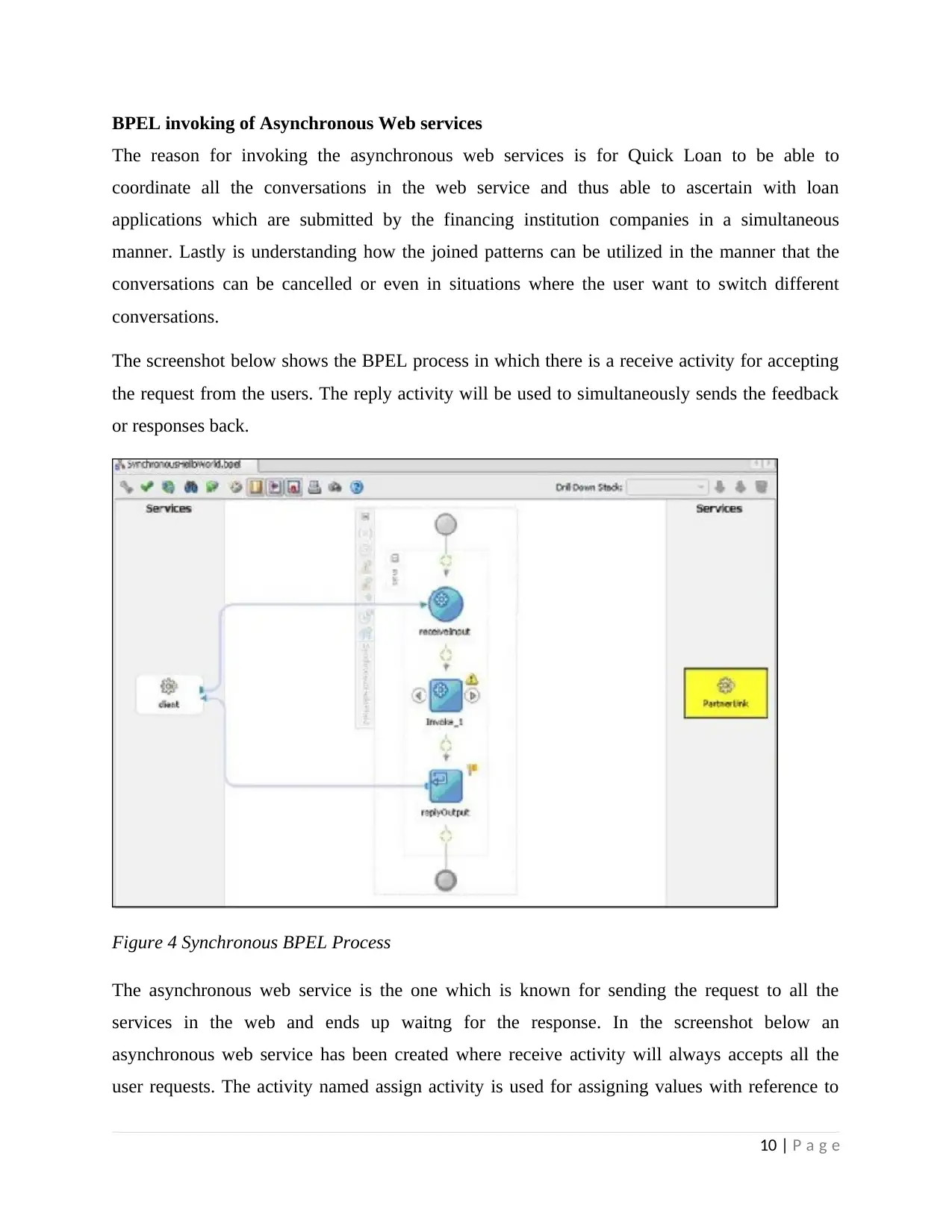
BPEL invoking of Asynchronous Web services
The reason for invoking the asynchronous web services is for Quick Loan to be able to
coordinate all the conversations in the web service and thus able to ascertain with loan
applications which are submitted by the financing institution companies in a simultaneous
manner. Lastly is understanding how the joined patterns can be utilized in the manner that the
conversations can be cancelled or even in situations where the user want to switch different
conversations.
The screenshot below shows the BPEL process in which there is a receive activity for accepting
the request from the users. The reply activity will be used to simultaneously sends the feedback
or responses back.
Figure 4 Synchronous BPEL Process
The asynchronous web service is the one which is known for sending the request to all the
services in the web and ends up waitng for the response. In the screenshot below an
asynchronous web service has been created where receive activity will always accepts all the
user requests. The activity named assign activity is used for assigning values with reference to
10 | P a g e
The reason for invoking the asynchronous web services is for Quick Loan to be able to
coordinate all the conversations in the web service and thus able to ascertain with loan
applications which are submitted by the financing institution companies in a simultaneous
manner. Lastly is understanding how the joined patterns can be utilized in the manner that the
conversations can be cancelled or even in situations where the user want to switch different
conversations.
The screenshot below shows the BPEL process in which there is a receive activity for accepting
the request from the users. The reply activity will be used to simultaneously sends the feedback
or responses back.
Figure 4 Synchronous BPEL Process
The asynchronous web service is the one which is known for sending the request to all the
services in the web and ends up waitng for the response. In the screenshot below an
asynchronous web service has been created where receive activity will always accepts all the
user requests. The activity named assign activity is used for assigning values with reference to
10 | P a g e
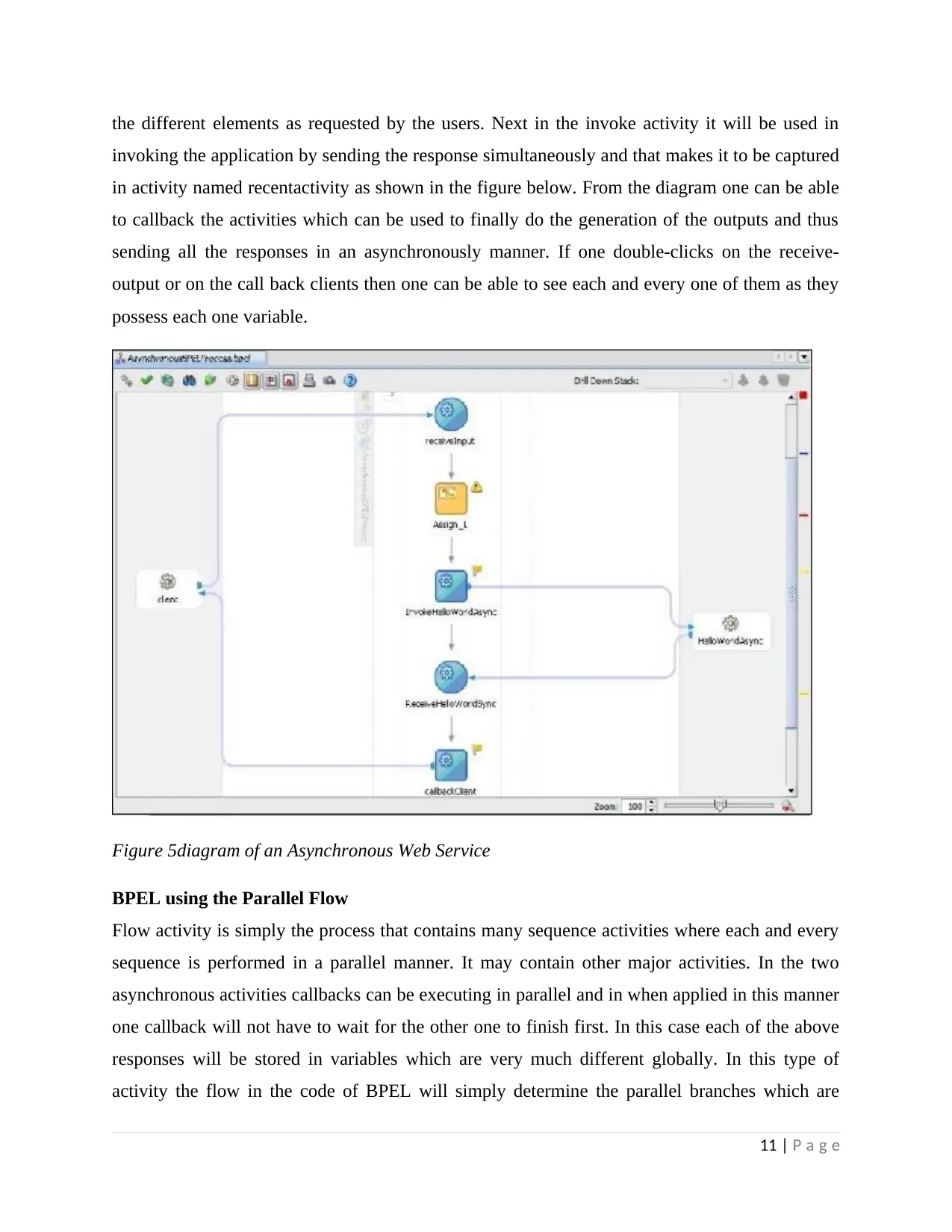
the different elements as requested by the users. Next in the invoke activity it will be used in
invoking the application by sending the response simultaneously and that makes it to be captured
in activity named recentactivity as shown in the figure below. From the diagram one can be able
to callback the activities which can be used to finally do the generation of the outputs and thus
sending all the responses in an asynchronously manner. If one double-clicks on the receive-
output or on the call back clients then one can be able to see each and every one of them as they
possess each one variable.
Figure 5diagram of an Asynchronous Web Service
BPEL using the Parallel Flow
Flow activity is simply the process that contains many sequence activities where each and every
sequence is performed in a parallel manner. It may contain other major activities. In the two
asynchronous activities callbacks can be executing in parallel and in when applied in this manner
one callback will not have to wait for the other one to finish first. In this case each of the above
responses will be stored in variables which are very much different globally. In this type of
activity the flow in the code of BPEL will simply determine the parallel branches which are
11 | P a g e
invoking the application by sending the response simultaneously and that makes it to be captured
in activity named recentactivity as shown in the figure below. From the diagram one can be able
to callback the activities which can be used to finally do the generation of the outputs and thus
sending all the responses in an asynchronously manner. If one double-clicks on the receive-
output or on the call back clients then one can be able to see each and every one of them as they
possess each one variable.
Figure 5diagram of an Asynchronous Web Service
BPEL using the Parallel Flow
Flow activity is simply the process that contains many sequence activities where each and every
sequence is performed in a parallel manner. It may contain other major activities. In the two
asynchronous activities callbacks can be executing in parallel and in when applied in this manner
one callback will not have to wait for the other one to finish first. In this case each of the above
responses will be stored in variables which are very much different globally. In this type of
activity the flow in the code of BPEL will simply determine the parallel branches which are
11 | P a g e
⊘ This is a preview!⊘
Do you want full access?
Subscribe today to unlock all pages.

Trusted by 1+ million students worldwide
1 out of 17
Related Documents
Your All-in-One AI-Powered Toolkit for Academic Success.
+13062052269
info@desklib.com
Available 24*7 on WhatsApp / Email
![[object Object]](/_next/static/media/star-bottom.7253800d.svg)
Unlock your academic potential
Copyright © 2020–2025 A2Z Services. All Rights Reserved. Developed and managed by ZUCOL.





